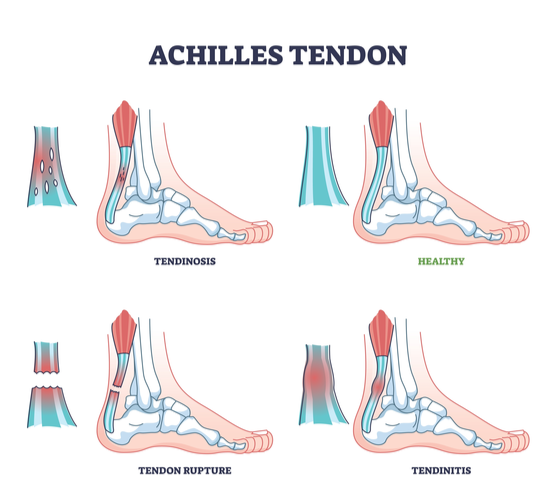Achilles Tendon Injuries
If something feels off in your foot or heel, do not hesitate to visit your local doctor for input- you could potentially be on the brink of a much more significant injury, and quick medical treatment can prevent this. In this example, we will be looking at preventative measures and warning signs for Achilles tendon ruptures and tendonitis in the foot and ankle. These are injuries that may require significant and prolonged treatment options, however, proper treatment and lifestyle accommodations can minimize the overall damage of these injuries and ensure a greater chance of recovery in Achilles Tendon Injuries patients.
How do I know if I am at risk for rupturing my Achilles tendon?
The Achilles tendon runs from the back of your lower leg into your heel and facilitates walking by helping to raise the heel off the ground. Injuries to the Achilles tendon are most common in so-called ‘weekend warriors’- middle-aged people who lead an active lifestyle and participate in sports in their spare time. In rare circumstances, medication or illnesses could potentially weaken the tendon’s overall strength, and make it more liable to tearing than it would otherwise be.
What does an Achilles tendon rupture feel like?
There are several common symptoms associated with this injury, including a sudden sharp pain in the ankle or calf, which will gradually subside into a dull ache, or an audible popping or snapping sensation. Other patients have reported feeling swelling on the back of the leg, and increased difficulty in walking upstairs or lifting themselves onto their toes.
I think I’ve ruptured my Achilles tendon. What should I do now?
We highly recommend patients follow the R.I.C.E. method until they are able to see a medical professional for a formal diagnosis. This consists of Rest, Ice, Compression, and Elevation. Don’t force yourself to walk on your injured foot- you could be causing further damage in the long run. Wrap ice in a thin towel and apply it to the area to reduce pain and swelling. Use an elastic bandage to cover the foot and ankle to reduce swelling. Lastly, try to keep your leg even with or slightly above heart level- this helps to reduce swelling and pain levels as well.
How is an Achilles rupture treated?
There are both surgical and non-surgical options for treating an Achilles tendon rupture. Non-surgical treatments, which are associated with a higher risk of re-injury, include using a cast, walking boot, or brace to restrict motion and allow the tendon to heal. This is generally used in instances where the tear is minor, the patient does not lead an active lifestyle, or for individuals with health conditions that would make surgery a riskier option. There are various surgical methods for fixing the tendon, and your surgeon will determine which is the best method to use for you personally. Following surgery, the foot will be immobilized in a cast or boot until it is determined by the surgeon to be capable of bearing weight. For both options, physical therapy is essential in order to reduce the risk of re-injury and properly acclimate the injured foot to bearing weight and mobility once more.



